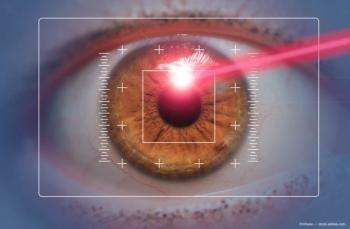
Flap creation with laser, microkeratome for LASIK offer similar results
Rochester, MN-"Bladeless" LASIK performed with a femtosecond laser was equivalent to LASIK performed with a microkeratome in a comparison study using a series of vision and eye health measurements.
Rochester, MN-"Bladeless" LASIK performed with a femtosecond laser was equivalent to LASIK performed with a microkeratome in a comparison study using a series of vision and eye health measurements.
Sanjay V. Patel, MD, study investigator and assistant professor of ophthalmology at Mayo Clinic College of Medicine, Rochester, MN, followed 20 patients who received LASIK for correction of myopia or myopic astigmatism.
"At 6 months after surgery, there were no differences between the eyes that had bladeless or microkeratome LASIK with respect to visual acuity, contrast sensitivity, or in perception of stray light," Dr. Patel said.
Patients were randomly assigned by ocular dominance to flap creation with a femtosecond laser (IntraLase FS, IntraLase Corp.) with intended flap thickness of 120 μm in one eye and flap creation with a microkeratome (Hansatome, Bausch & Lomb) with intended flap thickness of 180 μm in the other.
They were examined preoperatively and at 1, 3, and 6 months postoperatively. Outcome measures were backscatter, contrast sensitivity, forward light scatter, flap thickness, and patient preference when asked at 3 months.
Backscattered light was measured at each visit from digitized high-magnification video images of a slit-beam; forward light scatter was measured by a stray light meter. High-contrast visual acuity was measured by electronic-ETDRS, contrast sensitivity was measured by the Functional Acuity Contrast Test, and keratocyte examination and flap thickness measurements were obtained by confocal microscopy in vivo.
Results showed that corneal backscatter was higher after bladeless LASIK than after LASIK with the microkeratome at 1 month (p = 0.003, n = 20) and 3 months (p = 0.014, n = 20). In addition, corneal backscatter for both treatments was higher than before LASIK at 1 month (bladeless: p = 0.001, n = 20; microkeratome: p = 0.009, n = 20) and 3 months (bladeless: p = 0.002, n = 20; microkeratome: p = 0.031, n = 20).
Forward light scatter did not differ between eyes, and there was limited statistical power to detect a difference between preoperative and postoperative.
High-contrast visual acuity, measured as both best-corrected visual acuity (BCVA) and uncorrected visual acuity (UCVA), did not differ at any time, Dr. Patel said. Contrast sensitivity also did not differ.
Mean flap thickness at 1 month was 142 ± 16 μm SD for bladeless LASIK and 139 ± 22 μm for microkeratome LASIK (p = 0.563), both significantly different from intended thickness.
Patients were asked at 3 months whether they preferred the vision in either eye or had no preference. Seven patients preferred the microkeratome eye, five patients preferred the bladeless eye, and eight had no preference. The preferred eye was not associated with ocular dominance or better UCVA, Dr. Patel said.
Mayo Clinic investigators plan to follow these patients for 5 years to obtain long-term information about vision and eye health based on the type of LASIK procedure performed.
Newsletter
Don’t miss out—get Ophthalmology Times updates on the latest clinical advancements and expert interviews, straight to your inbox.
















































.png)


